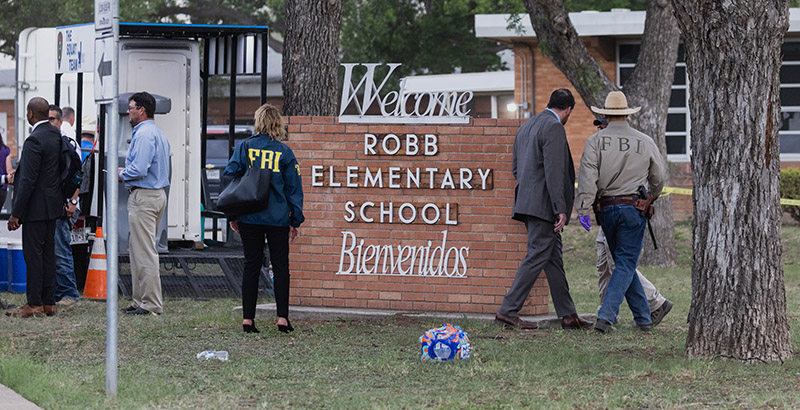The Contagion Effect: From Buffalo to Uvalde, 16 Mass Shootings in Just 10 Days
The latest mass shootings in Texas and New York highlight the frequency of such attacks — and how they can spread like a disease

Tuesday’s mass school shooting inside a Texas elementary school classroom was the deadliest campus attack in about a decade — and has refocused attention on the frequency of such devastating carnage on American victims.
The tragedy in Uvalde, Texas, which resulted in the deaths of at least 19 children and two teachers, unfolded just 10 days after the nation was shocked by a mass shooting that left 10 people dead at a supermarket in Buffalo, New York.
It could be more than a coincidence: A growing body of research suggests these assaults have a tendency to spread like a viral disease. A research theory called the contagion effect suggests that mass shootings often happen in clusters, with intense media coverage playing a significant role in subsequent attacks. About a dozen studies, dating to the 1970s, suggest this is the case.
The U.S. has experienced 16 mass shootings in just 10 days, including the carnage in Buffalo and Uvalde. That’s according to a tally by the Gun Violence Archive, which tracks shootings that result in at least four injuries or deaths. So far this year, the U.S. has endured 212 mass shootings in which four or more people were shot or killed, according to the archive.
The tragedy in Texas has reignited the country’s divisive and cyclical debate over gun laws, with President Joe Biden asking in an emotional White House address Tuesday night, “When in God’s name are we going to stand up to the gun lobby?”
Jaclyn Schildkraut, an associate professor of criminal justice at the State University of New York Oswego, said shooters are often motivated by a desire for fame. She’s a proponent of the “No Notoriety” campaign, which urges media outlets to limit the frequency with which they publish a shooting suspect’s name and photograph.
Attackers “want people to know who they are, they want their name recognition, and so when we remove that incentive and we don’t report their names, we aren’t rewarding people for killing other people by making them celebrities,” Schildkraut said. “It’s also removing the incentive for other like-minded individuals who may be seeing the amount of coverage that a case is getting and want similar attention.”
A day after the May 14 Buffalo supermarket assault, four people were killed and 23 were injured in five mass shootings: two in Texas, two in North Carolina and one in California. In one incident, a gunman attacked a lunch banquet at a Taiwanese church in Laguna Woods, California, resulting in one death and five injuries. In another, two people were killed and three injured after a gunman opened fire on a crowded flea market in Houston. More recently, on Monday, five people were injured in a shooting at a club in North Charleston, South Carolina.
While the Buffalo and Uvalde suspects are both 18-year-old men, a motive for the Texas school shooting remains unknown, as does the degree to which the perpetrator studied or was inspired by the incident in upstate New York or elsewhere. But Adam Lankford, a criminology professor at the University of Alabama, noted that the Texas suspect was active on social media and reportedly outlined plans on Facebook prior to the attack. The suspect reportedly posted photos of guns and communicated with a stranger online before the shooting, offering a cryptic message about what would soon unfold. Lankford said the suspect appeared to portray himself “as a mysterious, dangerous man who might do something like this.”
“He was dancing around the possibility that seemed likely that he would do something dramatic, perhaps dangerous, and perhaps a mass shooting,” Lankford said. “You can only dance around or imply that in a culture in which people are aware that young men with firearms too often do that.”
The Uvalde shooting was the deadliest attack on a school since the 2012 mass shooting at Sandy Hook Elementary School in Newtown, Connecticut, that killed 20 children and six educators.
In one 2015 study on the contagion effect, researchers at Arizona State University found a heightened probability of a mass shooting in the immediate aftermath of a similar attack with four or more victims. A second incident was statistically more likely to occur within 13 days, on average, researchers found.
Yet a similar contagion effect doesn’t appear to exist in the wake of attacks with just a few victims, “possibly indicating that the much higher frequency of such events compared with mass killings and school shootings reduces their relative sensationalism, and thus reduces their contagiousness,” according to the researchers.
So far this year, 27 shootings at K-12 schools have resulted in 67 injuries or deaths, according to a tally by Education Week, which has tracked such attacks since 2018. Prior to the shooting in Uvalde, the most recent campus attack unfolded just last week in Kentwood, Michigan. In that May 19 tragedy, two people were shot and injured after a Crossroads Alternative High School graduation ceremony.
In recent years, mass shootings in the U.S. have become “substantially more deadly over time,” according to a 2020 report by Lankford. Shooters often take inspiration from previous attacks and apply the lessons learned to their own. In fact, the number of mass shootings where eight or more people were killed has doubled in number since 2010, compared with the previous four decades.
The number of shooters who were inspired by previous attackers has also doubled, Lankford found. Between 1966 and 2009, a quarter of the deadliest shootings were perpetrated by someone who directly cited, referenced or studied a previous mass killer. Such direct influence was observed in half of the deadliest shootings between 2010 and 2019.
Older attacks seem to have a stronger direct influence than more recent events, Lankford said. The Buffalo suspect, for example, reportedly referenced the 2019 mass shootings at two mosques in Christchurch, New Zealand, in writing. Lankford noted that mass shooters often conduct extensive research and planning before carrying out their attacks and are unlikely to act impulsively after learning about the most recent shooting on the news. Rather, at-risk individuals who have already been considering violence could see the latest headline and decide that now is the time to act.
The rise of social media, Lankford said, has helped researchers understand how transmission occurs.
“We’re increasingly able to study the social media and internet searches of the perpetrators themselves, so what was in previous decades mere speculation about transmission can now be confirmed,” he said. “So, as just one example, we know what the Parkland shooter was googling and that he was looking up both things like the Virginia Tech shooting or the Columbine shooters, but then also a shooting that had just occurred several weeks earlier.”
While many questions about the Texas shooter remain unanswered, Schildkraut said it’s important to focus attention on the victims and their needs.
“There are so many people in years past who can tell you the names of shooters and not one of their victims, let alone all of their victims,” she said. “We just really need to refocus the attention on who matters in this, and it’s not the person who did the killing.”
Get stories like these delivered straight to your inbox. Sign up for The 74 Newsletter


